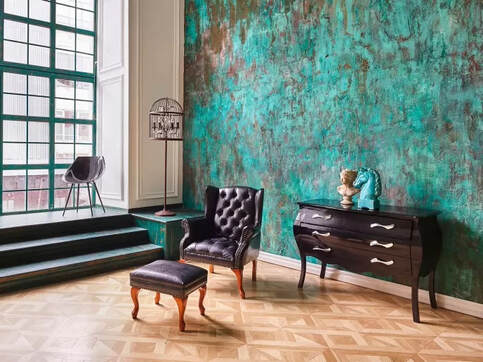 Sites Like AptDeco Are Changing The Selling Landscape Sites Like AptDeco Are Changing The Selling Landscape New York - Over the last ten years the options for antique dealers and vintage enthusiasts on where best to sell their wares online has become an increasingly refined process that has resulted in not only more precise and exact decorative arts listings, but has also created a wealth of new topic-specific industry websites specifically geared to such sales. Gone are the days when dealers were stuck with a broad spectrum two-choice listing on either eBay or Craigslist, or the sometimes unreliable and confusing categories of Facebook's Marketplace. Today, antique and vintage dealers can choose from a myriad of site-specific options when it comes to marketing their inventory online. To find out what sites worked best, staff writers at the school spoke to a number of industry insiders to get their take on how some online sales platforms have created or developed new approaches related to the marketing of decorative arts items, in order to offer dealers more choice and options when it comes to promoting their goods. Below, we've tabled some of those results. Offerup is one of Janet Cowers favorite selling sites. Cowers, who operates her own antique and vintage business in Portland, Oregon, says one of the sites best features is the integrated ability for buyers and sellers to negotiate out a price (hence the name). She's also fond of the regional approach whereby sellers and buyers can meetup to avoid any shipping fees. While some service fees can apply, they're not huge she says. As with many of today's best sites, you’ll need to download the app, provide some good quality photos, a well-written description, and a listing of your general geographic location. Cowers says she takes inventory that hasn't moved in a month and places it on Offerup at a discount. "So far the results have been outstanding," says Cowers, "I've really been able to save on the shipping of big items by loading-up multiple orders and delivering them in a single day to different local customers at one prearranged location." According to Cowers, she uses a large parking lot at a nearby conservancy hiking trial as a drop-spot, since it's highly visible, free, and offers lots of room for unpacking and packing-up for her clients. Going one step further on the regional purchasing and selling scale is Bookoo - a site that claims its legacy comes as a result of yard sale fans who decided to create a site for other yard sale fans (minus the actual going to yard sales part). Wendy Dalton who runs two vintage Etsy shops from New Jersey, says she's a believer. "I buy almost as much stock as I sell," she notes. "However, the great thing about Bookoo is how local it is - sometimes I'm literally only a block away from picking-up or selling some of my inventory." Dalton says she's used Offerup as well, but thinks prices are better on Bookoo. "They want everyone to know their site is garage sale sourced," she says, "which means you have to buy right in order to sell here and still make a profit." The registration process is straightforward though, and according to Dalton, once you're account has been setup, Bookoo lets you list an unlimited number of items. "I really like it because it has more of a community feel than some of the other sites," says Dalton, "It's almost like a chat-group!" Thomas Dryer is also a fan of regional buying and selling. Hailing from San Francisco with both an online presence and bricks & mortar shop, Dryer says he previously used eBay for his online sales but became tired of the escalating prices. Today, he says he's switched to eBid for listing and selling some of his finer vintage stereos from the 1970s and 80s using a local pick-up option. Aside from their very low commission rate of 3%, Dryer feels that eBid is a great alternative for those wanting to avoid rising fees associated with conducting business on eBay. "They have literally all the same features as eBay," says Dryer, "including the ability to import any of my items on eBay, directly over to my eBid account, which means I can get a lot more exposure for some of my items." Dryer says that his sales have been just as good on eBid, and that he's currently considering a lifetime membership for $50 that would drop his already low fees even more. "It's a win-win," says Dryer, "I'm saving money and selling more."  Sites Like Offerup Encourage Members To Meet Locally Sites Like Offerup Encourage Members To Meet Locally Remoov has become a recent favorite for many antique and vintage dealers because of its full-service offerings. Maria Alcaraz, who operates a number of consignment and vintage shops around the Tempe area in Arizona, says that it's all about the ease of use. "When something hasn't moved, and I need it gone to create more space for fresh inventory," she says, "I can literally take a few pictures, and set-up an appointment for the folks at Remoov to come and get my stuff." Alcaraz acknowledges that sharing the 50/50 split with the company after the item sells means there's not much room for error on her part, but notes that they're paying for the pickup, listing, and resale of the items. "I think that's pretty fair," she says, "and it allows me to dispose of slow moving inventory while still getting paid." If you're in the Northeast, like Natalie Barber is, then you're in luck. Barber, who owns a higher-end mid-century modern and vintage business in the San Francisco Bay area, says she uses AptDeco almost exclusively as her online go-to when it comes to selling large furniture pieces. According to Barber, listing only takes a couple minutes and AptDeco handles all the moving and pick-up. "I'm tiny, so loading and unloading big pieces of furniture can be an issue for me, that's why I like AptDeco so much," she says. Aside from the convenience factor, Barber also likes the fact that rates are reasonable (23% on sales), but more importantly, she says she likes that the average time from pick-up to pay-out is around ten to fifteen days. "It means the money I spent on past inventory isn't just languishing around for months in a company's warehouse." Finally, for those in the business who deal almost exclusively in the top-end range of the decorative arts field, there's Sotheby's Home (Buy Now) option, which according to New York dealer Carl Franks, is one of the better online venues when it comes to selling Georgian furniture. "I've tried them all," says Franks, "including 1stdibs, Charish, Ruby Lane, and more, but for me, Sotheby's has been by far the best." Franks admits that the listing prices ($1000 minimum), and commissions can be quite high (around 50%), but says for that kind of money you get a team of experts to review your submissions and who'll be there to proactively sell your items to a selective audience. For many dealers over the last few years, the growing number of options available for online inventory sales has simply come down to a greater combination of choice and selectivity rather than just gross site viewership. No longer stuck with single all-encompassing listings on behemoth websites that have little relativity to local sales, dealers it would seem have now finally found their niche in decorative arts websites that seem more geared towards them, rather than everybody else. For those looking to enter into the current decorative arts field, this is certainly good news, as it should provide nascent dealers with additional streams of revenue sources aside from today's standard online and main street formats. - A.I.A. Staff Writers  NOTE: For readers seeking more information about the Asheford Institute Of Antiques distance-learning program on professional-level appraising, the study of antiques, collectibles, vintage and mid-century modern items, please click here to visit the school's Home Page. Should you have additional questions about the Asheford program, you can also write to the school at: info@asheford.com or call the Registrar's Office toll-free at: 1-877-444-4508.  Antique & Vintage Sales "Tops" In Decorative Arts Markets Antique & Vintage Sales "Tops" In Decorative Arts Markets New York - Oh, what a difference a few years can make, especially when it comes to the world of the decorative arts. From proclamations of "It's over," to "people just don't want that old stuff anymore," the claims relating to the demise of the antique and vintage industry over the last twenty years have been about as plentiful and exaggerated as those levelled against the famed American satirist, Mark Twain. In fact, not only has the antique and vintage industry been thriving recently, but since the onset of the pandemic, the public's demand for decorative arts items from the past has literally exploded across every major sales platform to be had - from bricks and mortar shops, to pop-ups, and every conceivable type of online concern in between - the antique and vintage industry is now experiencing a wave of popularity and profitability that up until now, has never been seen before. Bolstering this claim, the most recent Global Home Furnishings report, produced by ResearchandMarkets.com, which tallies worldwide sales for this sector, indicated that while everyone had clearly spent more time at home during the last few years due to the pandemic, they also spent more money to furnish their homes, with worldwide decorative arts spending growing over twenty-eight billion dollars year-over-year. While e-commerce sites specifically related to decorative furnishings saw growth across the board, one market category from the report in particular stood out for the massive increase in sales volumes above all others; the antique, vintage, and consignment industry. As would be expected with reports of this ilk, theories abound as to why this particular area of the decorative arts segment is seeing such a strong resurgence in popular interest lately. However, for many industry insiders, the answer to that question may be more about a convergence of multiple market conditions and coincidental timing, rather than a single determining factor or theory. For Janet Cain, who runs three separate Instagram stores, it's all about the pandemic. "It really started there," she says, "from the moment Covid hit, sales literally blew-up and haven't stopped since." Cain believes that people got used to seeing and tracking items online from the comfort of their home, which made purchasing super easy, and by extension, created more opportunities for buying. "I have more repeat customers than ever," says Cain, "and their buying a lot more than before." Cain thinks that in some ways the pandemic created a new world-order when it came to making purchases online. "Before it was a choice, but during Covid it often became your only option," she says. "Now I think people have just gotten used to it and enjoy the convenience of not having to trek across the countryside in search of that perfect find." Others in the industry see a larger overall picture when it comes to understanding the recent surge in popularity for everything antique and vintage. Anna Brockway, the co-founder and president of Chairish, an international online antique and vintage furniture site, whose revenue has more than doubled in the past year, thinks that there is no question that vintage is hot right now. Brockway says, "Not only is vintage furniture beloved for its chic, one-of-a-kind style, it’s also increasingly appreciated for its immediate availability and sustainability. Right now, due to serious supply chain snarls, contemporary furniture manufacturing and delivery is moving at a glacial pace, while shoppers' expectations around speed and instant availability have never been higher." Posters who've listed items for sale on Chairish, say it's a clear example of buyers (especially younger ones), increasingly wanting sustainable and unique items with a little history to them instead of the sameness that often comes from big-box stores. Another piece of the puzzle, at least according to Christina Williams, who runs a number of high-end consignment shops in and around Atlanta and Savannah, thinks the explosive growth of interest in antique and vintage furnishings is also likely a direct result of price. Why? Because, for the most part, consignment pricing for quality items is almost always going to be cheaper than purchasing comparably newer items, which makes the consignment option an attractive proposition for savvy buyers, especially during uncertain economic times. Williams says her numbers over the last twelve months have been so strong that she now has a 'buy team' that scours high-end Atlanta neighborhoods with homes for sale in an attempt to beat out Estate Sale companies for the rights to sell the clients goods and chattels. "Demand is so strong," says Williams, "that if I didn't get to some of these houses first, and come out with a signed contract, I probably wouldn't have enough inventory at months end to stock my stores." Statista, an international company that specializes in market and consumer data for businesses, says that conservatively they expect the antique, vintage, and consignment furniture resale market to increase by over seventy-percent in the next few years. So what's fueling this current market growth? Well, for starters, many analysts point to the changing buying tastes of young Millennials and Gen Z consumers who started the "used" trend with vintage clothing, while seamlessly transitioning that into used furniture. Originally part of the Ikea mindset, many began to finally balk at the uniformity of design, and instead sought out uniqueness in not only their clothes but home furnishings as well. Now, with some discretionary income finally arriving, Millennials and Gen Z'ers are pursuing even more one-of-a-kind purchases that are in keeping with their collecting preferences, and which often come with a more expensive price tag. In fact, in a recent survey conducted by Chairish, over thirty-one percent of Millennial and Gen Z respondents said that they had become much more interested in buying used, vintage, and antique furniture online over the last two years, than in the two years prior. Jason Stavros, a young engineer from San Diego, perhaps embodies this new generation of decorative arts enthusiasts best, as he seemingly identifies with many of the factors that appear to be connected to the popular themes currently attributed to the rise of interest in the antique and vintage marketplace. "I'm an engineer by trade," says Stavros, "but I started buying and selling second-hand stuff just before the pandemic struck as way to save after I graduated university." Today, Stavros says that his interest in the decorative arts is more about being unique, buying something with a sense of history, helping the environment by upcycling, and avoiding supply-chain issues where possible. "I list on Chairish and quite a few other sites in my spare time," says Stavros, "but business has been so good recently that I'm giving serious consideration to hanging my own shingle and hitting it full-time... Or, as I like to call it, time to bring in the old!" - A.I.A. Staff Writers  NOTE: For readers seeking more information about the Asheford Institute Of Antiques distance-learning program on professional-level appraising, the study of antiques, collectibles, vintage and mid-century modern items, please click here to visit the school's Home Page. Should you have additional questions about the Asheford program, you can also write to the school at: info@asheford.com or call the Registrar's Office toll-free at: 1-877-444-4508. |
AIA StaffWe're providing our students and reader's with the latest breaking news on events and happenings that we think might be of interest to both collectors and dealers alike. Including changes within the world of antiques, vintage, collectibles and appraising that might just have an effect on your bottom line. We're also interested in hearing from you - so if you've got a great newsworthy story, let us know, and you just might find it here! Archives
July 2024
CategoriesLegal Disclaimer: Extraneous opinions, statements and comments made by individuals represented within these posts do not necessarily reflect those of the Institute. The publication naming of specific business entities, organizations, and concerns, contained herein, in no way represents an endorsement or recommendation of services or products by the Institute. Publicly identifiable information contained herein (including, but not limited to contact information), has been intentionally limited where possible, due to privacy and legal concerns related to the digital dissemination of information through online means. All views expressed herein are those of their respective owners. The Institute is in no way responsible, financially or otherwise, for the accuracy or validity of statements contained within published posts from sources that originate and appear outside of the written and expressed views of those submitted by the Institute.
|




 RSS Feed
RSS Feed




